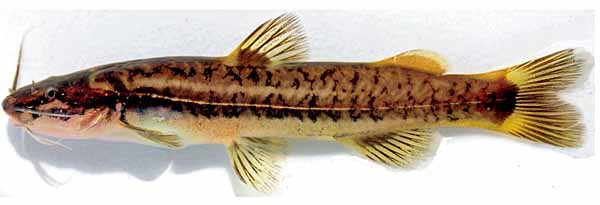Cetopsorhamdia spilopleura
Bockmann & Reis, 2021
|
Familie: Heptapteridae |
Typen
Holotypus: MZUSP 121503.
Siehe: Eschmeyer, W.N., Fricke, R. & Van der Laan, R. (eds.) 2024. Catalog of Fishes electronic version
Typusfundort: Brasilien, Bundesstaat Mato Grosso, Comodoro, Bach ohne Namen der dem Rio Doze de Outubro zufließt, Rio Tapajós Einzug, ca. 25 km von Vilhena (Bundesstaat Rondônia), auf dem Highway BR‑364, bei Chapada dos Parecis, 12°57'50"S, 60°01'40"W (Karte).
Etymologie
Spilos (= Fleck, Klecks); pleura (= seitlich), eine Anspielung auf das Fleckmuster der Flanken.
Verbreitung
Brasilien: nur aus dem Rio Doze de Outubro, einem Nebenfluss des oberen Rio Juruena, im oberen Rio Tapajós-System, im Bundesstaat Mato Grosso, bekannt.
IUCN Status

EX Extinct (ausgestorben)
EW Extinct in the Wild (in der Natur ausgestorben)
CR Critically Endangered (vom Aussterben bedroht)EN Endangered (stark gefährdet)
VU Vulnerable (gefährdet)
NT Near Threatened (potenziell gefährdet)
LC Least Concern (nicht gefährdet)
RE Regionally Extinct (regional oder national ausgestorben)DD Data Deficient (ungenügende Datengrundlage)
NE Not Evaluated (nicht beurteilt)
Status: Stand 6.06.2021: NE Not Evaluated (nicht beurteilt)
Gefahren für diese Art: (nicht beurteilt)
Literatur
- Bertaco, V.A. & Carvalho, T.P. 2005. A new characid fish, Hyphessobrycon hexastichos (Characiformes: Characidae) from Chapada dos Parecis, Mato Grosso, Brazil. Neotropical Ichthyology, 3 (3): 439-443. (doi) Zitatseite [: 145, als Cetopsorhamdia sp.]
- Bockmann, F.A. & Reis, R.E. 2011. Two new, beautifully-colored species of the Neotropical catfish Cetopsorhamdia Eigenmann and Fishes, 1916 (Siluriformes, Heptapteridae) from western Brazil, with a cladistic analysis of the genus. In: Abstracts for the 2011 Joint Meeting of Ichthyologists and Herpetologists, Minneapolis, Minnesota, 6‑11 July 2011. Minneapolis, AES, ASIH, HL, NIA, SSAR, [auf CD-ROM]. Zitatseite [ (Verbreitung, Kurzbeschreibung, phylogenetische Beziehung), als Cetopsorhamdia new species 2]
- Ohara, W.M. & Loeb, M.V. 2016. Ichthyofauna of the upper Juruena river on Chapada dos Parecis, Mato Grosso, Brazil. Biota Neotropica, 16 (4): 1-10. (doi) Zitatseite [: 5, fig 4, als Cetopsorhamdia sp.3]
- Bockmann, F.A. & Reis, R.E. 2021. Two new, remarkably colored species of the Neotropical catfish genus Cetopsorhamdia Eigenmann & Fisher, 1916 (Siluriformes, Heptapteridae) from Chapada dos Parecis, western Brazil, with an assessment of the morphological characters bearing on their phylogenetic relationships. Papéis Avulsos de Zoologia, 61: e20216156. (doi) Zitatseite [: 15, Figs 12-15, !!]
